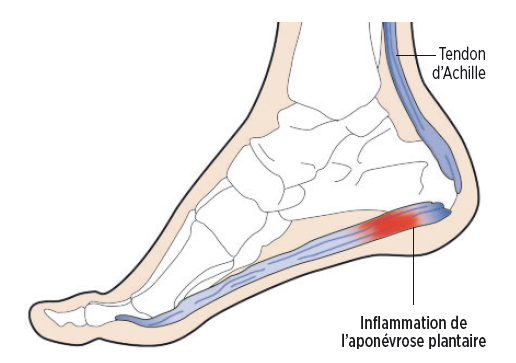Plantar fasciitis is a tension in the tissues located at the level of the plantar fascia: located under the foot, it extends from the heel to the base of the toes. It is estimated that 10 to 15% of consultations with the podiatrist are due to this pathology ¹ . It is a recurring problem among regular runners, being one of the most common injuries with 5 to 10% of runners suffering from plantar fasciitis each year ².
Understanding what the arch of the foot is
Babies and young children up to the age of 4-5 years mostly have flat feet. As they grow, the muscles, tendons, and ligaments tone up, and the bones develop, creating different arches (3 to be exact) forming the arch of the foot ³. It is formed by tendons that, like elastic bands, connect the heel (calcaneus bone) to the different bones of the foot. ¼ of the bones are located in our feet, so imagine the work of our beloved muscles and tendons!
Where does inflammation, tendonitis on the bottom of the foot, come from?
Inflammation of the membrane is also called plantar fasciitis . This problem is usually caused by a mechanical defect in the foot, overwork, or excess weight.
It is important to understand that plantar fasciitis is a wear-and-tear problem: it often takes years of repeated trauma before pain is felt. It is likely that plantar fasciitis is the result of microtraumas that accentuate the normal aging process of the plantar fascia ⁴.
See a podiatrist for a complete diagnosis
A podiatric consultation involves several phases of analysis (static, dynamic) until the problem is defined. If necessary, the prescription of a pair of orthopedic insoles (plantar orthoses) can lead to a correction of posture / length / or even flat feet which particularly suffer from the pain of plantar fasciitis⁵. Nothing better than a personalized support thanks to the podiatric study of an expert, an ode to protection under a benevolent sign, trust your specialist.
The predominant role of the Wizwedge support arch, combined with the curvature of the first mounting
Strengthening the structure of the shoe to ensure optimal stability of the outsole is the role of the support arch! Promoting a balanced posture is a first point of the system's effectiveness on this pathology.
Respecting the biomechanics of the foot is the second: preventing the torsion of the part encompassing the arch of the foot, a protective phenomenon not to be neglected, the foot rests on a stable base, indented under the arch of the foot thanks to the studied architecture, the harmful underlying vibrations are therefore considerably reduced and this system prevents the natural wear of the arch of the foot. Today, many health professionals (doctors, physiotherapists, osteopaths, podiatrists, etc.) recommend Wizwedge shoes to considerably limit the risk factors that could promote or trigger plantar fasciitis.
Dual use with posterior muscle chain relief
The heel elevation designed using the removable and customizable wedge system allows for a considerable improvement in overall posture and stability of support depending on the subject's weight and practice.
This allows for a very complementary approach to that of the care provided by the podiatrist in order to be able to treat the tension and pain induced by plantar fasciitis.
Relieve your pain with Wizwedge!
Sources:
² "What are the main running-related musculoskeletal injuries? A Systematic Review" , Lopes AD.
³ Our team of research engineers based on their research
⁴ ⁵ Jean-Luc Guer, Podiatrist and Founder of Wizwedge



Leave a comment
All comments are moderated before being published.
This site is protected by hCaptcha and the hCaptcha Privacy Policy and Terms of Service apply.